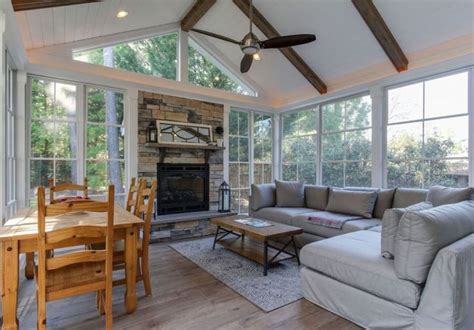How To Heat A 3 Season Room
Ronan Farrow
Apr 01, 2025 · 3 min read

Table of Contents
How to Heat a 3-Season Room: A Guide to Cozy Comfort
A 3-season room—that delightful space bridging the indoors and outdoors—can be a haven of relaxation, a vibrant extension of your home, or even a productive workspace. But when autumn's chill arrives, or winter's bite takes hold, the enjoyment can quickly fade without proper heating. This comprehensive guide will explore effective and efficient heating solutions for your 3-season room, transforming it into a year-round sanctuary.
Understanding the Challenges of Heating a 3-Season Room
Unlike fully insulated rooms, 3-season rooms typically feature thinner walls, more windows, and less insulation. This means heat escapes much faster, leading to higher heating costs and difficulty maintaining a comfortable temperature. Successfully heating a 3-season room requires understanding these challenges and choosing the right heating approach. Key factors to consider include:
- Insulation: Assessing the current insulation level is critical. Better insulation will significantly reduce heat loss, making your chosen heating solution more effective and energy-efficient. Consider adding insulation to walls, floors, and ceilings where possible.
- Window Efficiency: Windows are often the biggest culprits of heat loss. Consider upgrading to energy-efficient windows, or adding window coverings like thermal curtains or insulated blinds.
- Air Leaks: Seal any air leaks around windows, doors, and other openings to prevent drafts and improve overall efficiency. Caulk, weatherstripping, and expanding foam can be helpful tools in this process.
- Room Size: The larger the room, the more powerful the heating solution you'll need. Accurate measurements are essential for selecting a suitable heater.
Effective Heating Solutions for Your 3-Season Room
Several heating options cater to the specific needs of a 3-season room. Here are some of the most popular and effective choices:
1. Electric Space Heaters: A Quick and Convenient Solution
Electric space heaters are a readily available and relatively inexpensive option. They offer quick heat, are easy to install, and come in various sizes and styles. However, they can be less energy-efficient than other methods, and depending on usage, may increase electricity bills. Consider these types:
- Radiant Heaters: These heaters warm objects directly, making them energy-efficient in small spaces.
- Convection Heaters: These heaters warm the air, providing consistent heat throughout the room.
- Fan Heaters: These heaters use a fan to circulate warm air, offering quick heat distribution but potentially drying the air.
Remember to choose a heater with the appropriate wattage for your room size.
2. Portable Propane Heaters: Powerful and Efficient
Portable propane heaters offer a powerful and efficient heating solution, particularly in larger 3-season rooms. They are less reliant on electricity and can provide significant warmth. However, proper ventilation is crucial to prevent carbon monoxide buildup. Always ensure adequate ventilation and follow safety guidelines meticulously.
3. Infrared Heaters: A Comfortable and Energy-Efficient Option
Infrared heaters radiate heat, warming objects and people directly rather than heating the air. This makes them energy-efficient and comfortable, and they can also be used in partially insulated spaces. While they're generally more expensive than electric heaters, they deliver a highly effective heat experience.
4. Mini-Split Heat Pump: A Long-Term Investment
A mini-split heat pump is a more substantial investment but provides excellent energy efficiency and consistent heating throughout the year. These systems provide both heating and cooling, making them a versatile solution for your 3-season room. Professional installation is required.
Choosing the Right Heating System for Your Needs
The best heating solution depends on various factors:
- Budget: Electric space heaters are the most affordable, while mini-split heat pumps represent a more significant investment.
- Energy Efficiency: Heat pumps offer the highest energy efficiency, followed by infrared heaters, while electric heaters are the least efficient.
- Room Size: Larger rooms may necessitate more powerful heating solutions.
- Ventilation: Propane heaters require careful consideration of ventilation.
By carefully considering these factors and the information presented in this guide, you can choose the ideal heating solution to transform your 3-season room into a comfortable and enjoyable space all year round. Remember to prioritize safety and efficiency in your decision-making process.
Featured Posts
Also read the following articles
| Article Title | Date |
|---|---|
| How To Keep Dog Door Flap From Blowing Open | Apr 01, 2025 |
| How To Make A Gymnastics Routine | Apr 01, 2025 |
| How To Lubricate Boat Throttle Cable | Apr 01, 2025 |
| How To Install Stained Glass Window | Apr 01, 2025 |
| How To Keep Birds Out Of Your Barn | Apr 01, 2025 |
Latest Posts
Thank you for visiting our website which covers about How To Heat A 3 Season Room . We hope the information provided has been useful to you. Feel free to contact us if you have any questions or need further assistance. See you next time and don't miss to bookmark.
